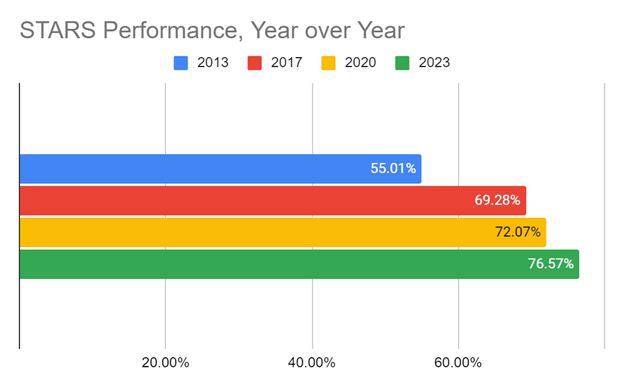Breadcrumb
STARS: Sustainability Tracking, Assessment & Rating System
Cal Poly Humboldt will undertake the task of proving we are serious about sustainability—again!
During Academic Year 2025-2026, Humboldt will evaluate sustainability across campus, assessing performance for the fifth time with a self-reporting framework called Sustainability Tracking, Assessment & Rating System (STARS). Access all past STARS reports here.
Over time, Humboldt has increased our STARS rating from 55.01 (Silver rating, 2013) to 76.57 (Gold rating, 2023), which represents a more than 20 point increase in our performance over time!! This helps demonstrate that Humboldt is a premier institution for students, staff, and faculty seeking learning opportunities and model behaviors for sustainability in higher education.

As the campus continues to use STARS as an iterative improvement tool, we seek to become the first CSU to earn a Platinum rating. While the STARS tool was upgraded to version 3.0 in 2024 and our "Path to Platinum" will look different with updated and new criteria, readers may view an older 2020 Path to Platinum Report, which outlined targeted strategies for achieving the elusive platinum rating (a score of 85 or higher is needed) from STARS. An updated gap analysis will be forthcoming after we finalize and publish our 2026 STARS report under version 3.0.
What is AASHE STARS?
STARS is a transparent, self-reporting framework for colleges and universities to measure their sustainability performance. This system was developed by the Association for the Advancement of Sustainability in Higher Education (AASHE) with broad participation from diverse representatives of the higher education community. Because Humboldt is an active member of AASHE, all students, staff, and faculty at our institution have access to AASHE’s online resources, which include opportunities for networking, information sharing, collaboration and professional development.
Read more about AASHE’s member benefits here.
History of Cal Poly Humboldt & STARS
As some may recall, in 2012-2013 the greater campus community at Cal Poly Humboldt participated in its first-ever STARS report. With the help of the Office of Sustainability, reporters from various departments throughout campus gathered a myriad of data relating to their respective operations and responsibilities. The first report set a baseline by which to compare performance in future iterations. Humboldt has now repeated the STARS assessment process four times, and will undergo our next iteration during the 2025- 2026 Academic Year.
- Humboldt's 2023 final STARS Report: here. Review a comparison of performance year over year here.
- Humboldt's 2020 final STARS report: here. Review a snapshot of points earned in 2020 here.
- Humboldt's 2017 inal STARS report: here. Review an Executive Summary of the report from 2017 here. Download the slides from a summary presentation about the 2017 report here.
- Humboldt's 2013 final STARS Report: here.
What makes STARS different?
AASHE’s STARS program is the only one of its kind that involves publicly reporting comprehensive information related to a university’s sustainability performance. Unlike other rating or ranking systems, this program is open to all institutions of higher education throughout the world, and the criteria that determine a STARS rating are transparent and accessible to anyone. Because STARS is a program based on credits earned, it allows for both internal comparisons as well as comparisons with similar institutions.
How does the STARS system work?
- STARS is broken into four sectors: Academics (AC), Engagement (EN), Operations (OP), and Planning & Administration (PA).
- Each sector is further tiered into data credits that describe specific metrics, activities, or practices throughout campus.
- Fulfillment of credits allows the University to accumulate points.
- STARS awards a rating of platinum, gold, silver or bronze based on earned points.
- The data used to assign points are made public so that institutions may compare their own activities to those of other campuses, and get inspiration for ways to improve and achieve success.
How can I get involved with STARS?
While only designated reporters and their departmental leads will be responsible for delivering in-depth sustainability information for the STARS report, every single stakeholder on campus plays a role in some element of making Humboldt a more sustainable campus. STARS evaluates all levels of campus activity, from how many student groups on campus are focused on sustainability, to the recycled content in office paper, to the policies our university has in place to promote social equity, justice, and diversity. Campus stakeholders, in particular staff and faculty, are encouraged to incorporate sustainability concepts into their jobs and daily responsibilities, operationalizing these concepts as common and routine exercises at Humboldt. Students may find data included in the STARS report helpful when researching campus practices for class or when they are simply curious about processes in place on this campus.
To get involved in a variety of sustainability initiatives on campus or to find out more about STARS, contact:
- Katie Koscielak, Sustainability Analyst
- kmk928@humboldt.edu (Email)
- 707-826-5945 (Campus phone)
A Typical Humboldt STARS Timeline
July
Office of Sustainability preps training materials for campus reporters
Aug
Campus team attends introduction and orientation sessions led by Office of Sustainability
Sept– Dec
Reporters enter data to the STARS online reporting tool
Jan - Feb
Office of Sustainability reviews STARS data and fills gaps
Feb - March
Humboldt receives internal and external reviews by students and a third party sister campus
April
Data is formally submitted to STARS in order to receive a final rating
May
Final rating is announced to campus
Following completion of a STARS report, the campus spends the proceeding academic year reviewing findings and crafting action plans for improvement with departments across campus.
Every three years, the campus will repeat the reporting process in hopes of achieving an increase to the STARS rating.





